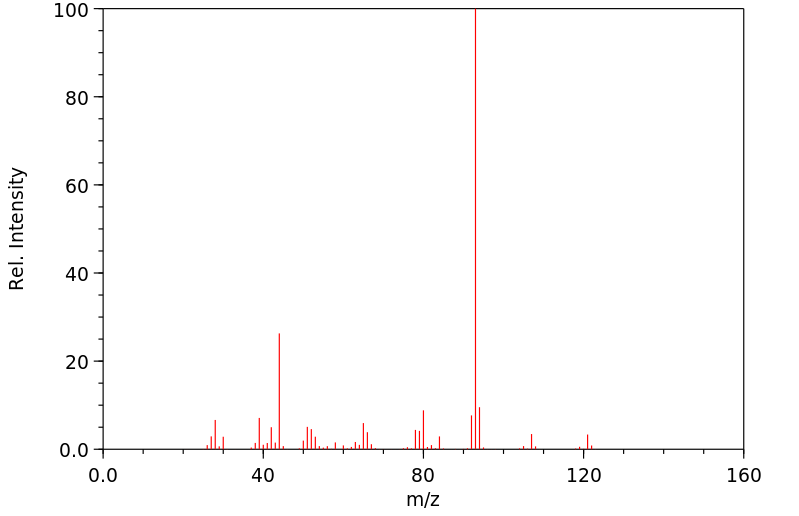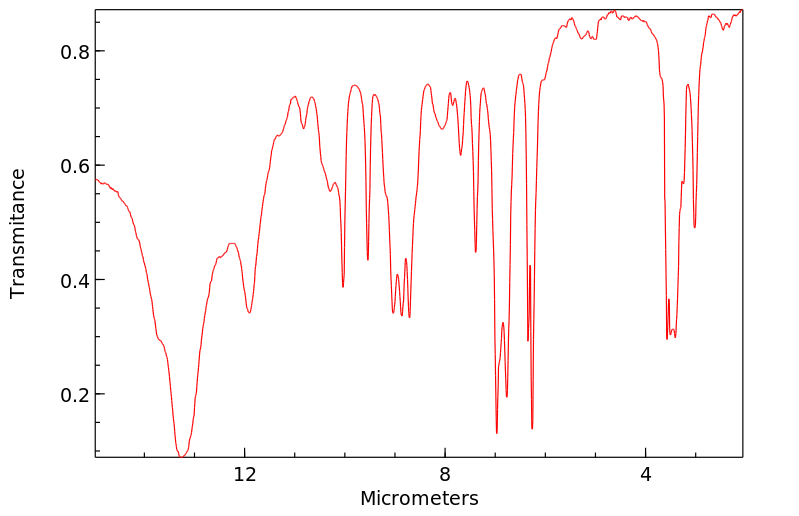2-[(甲氨基)甲基]吡啶 | 21035-59-6
中文名称
2-[(甲氨基)甲基]吡啶
中文别名
N-甲基-1-吡啶-2-甲胺;N-甲基-2-吡啶甲胺
英文名称
N-methyl-2-pyridinemethanamine
英文别名
methyl-pyridin-2-ylmethyl-amine;N-methyl-1-(pyridin-2-yl)methanamine;2-(methylamino)methylpyridine;2-Pyridinemethanamine, N-methyl-;N-methyl-1-pyridin-2-ylmethanamine
CAS
21035-59-6
化学式
C7H10N2
mdl
MFCD02089407
分子量
122.17
InChiKey
OOTKJPZEEVPWCR-UHFFFAOYSA-N
BEILSTEIN
——
EINECS
——
-
物化性质
-
计算性质
-
ADMET
-
安全信息
-
SDS
-
制备方法与用途
-
上下游信息
-
文献信息
-
表征谱图
-
同类化合物
-
相关功能分类
-
相关结构分类
物化性质
-
熔点:64 °C
-
沸点:78-80 °C(Press: 10 Torr)
-
密度:0.994 g/mL at 25 °C
-
闪点:82℃
计算性质
-
辛醇/水分配系数(LogP):0.3
-
重原子数:9
-
可旋转键数:2
-
环数:1.0
-
sp3杂化的碳原子比例:0.285
-
拓扑面积:24.9
-
氢给体数:1
-
氢受体数:2
安全信息
-
危险等级:IRRITANT
-
危险品标志:Xi
-
海关编码:2933399090
-
WGK Germany:3
-
危险性防范说明:P261,P305+P351+P338
-
危险性描述:H302,H315,H319,H335
-
储存条件:室温且干燥
SDS
Section 1. IDENTIFICATION OF THE SUBSTANCE/MIXTURE
Product name : Methyl(2-pyridylmethyl)amine
Section 2. HAZARDS IDENTIFICATION
Classification of the substance or mixture
According to Regulation (EC) No1272/2008
Acute toxicity, Oral (Category 4)
Skin irritation (Category 2)
Serious eye damage (Category 1)
Specific target organ toxicity - single exposure (Category 3)
According to European Directive 67/548/EEC as amended.
Harmful if swallowed. Irritating to respiratory system and skin. Risk of serious damage to eyes.
Label elements
Pictogram
Signal word Danger
Hazard statement(s)
H302 Harmful if swallowed.
H315 Causes skin irritation.
H318 Causes serious eye damage.
H335 May cause respiratory irritation.
Precautionary statement(s)
P261 Avoid breathing dust/ fume/ gas/ mist/ vapours/ spray.
P280 Wear protective gloves/ eye protection/ face protection.
P305 + P351 + P338 IF IN EYES: Rinse cautiously with water for several minutes. Remove
contact lenses, if present and easy to do. Continue rinsing.
Hazard symbol(s)
Xn Harmful
R-phrase(s)
R22 Harmful if swallowed.
R37/38 Irritating to respiratory system and skin.
R41 Risk of serious damage to eyes.
S-phrase(s)
S26 In case of contact with eyes, rinse immediately with plenty of water and
seek medical advice.
Other hazards - none
Section 3. COMPOSITION/INFORMATION ON INGREDIENTS
Formula : C7H10N2
Molecular Weight : 122,17 g/mol
CAS-No. EC-No. Index-No. Classification Concentration
Methyl(2-pyridylmethyl)amine
21035-59-6 244-160-1 - Acute Tox. 4; Skin Irrit. 2; Eye -
Dam. 1; STOT SE 3; H302,
H315, H318, H335
Xn, R22 - R37/38 - R41
For the full text of the H-Statements mentioned in this Section, see Section 16.
Section 4. FIRST AID MEASURES
General advice
Consult a physician. Show this safety data sheet to the doctor in attendance.
If inhaled
If breathed in, move person into fresh air. If not breathing, give artificial respiration. Consult a physician.
In case of skin contact
Wash off with soap and plenty of water. Consult a physician.
In case of eye contact
Rinse thoroughly with plenty of water for at least 15 minutes and consult a physician.
If swallowed
Do NOT induce vomiting. Never give anything by mouth to an unconscious person. Rinse mouth with water.
Consult a physician.
Section 5. FIRE-FIGHTING MEASURES
Suitable extinguishing media
For small (incipient) fires, use media such as "alcohol" foam, dry chemical, or carbon dioxide. For large fires,
apply water from as far as possible. Use very large quantities (flooding) of water applied as a mist or spray;
solid streams of water may be ineffective. Cool all affected containers with flooding quantities of water.
Special protective equipment for fire-fighters
Wear self contained breathing apparatus for fire fighting if necessary.
Further information
Use water spray to cool unopened containers.
Section 6. ACCIDENTAL RELEASE MEASURES
Personal precautions
Use personal protective equipment. Avoid breathing vapors, mist or gas. Ensure adequate ventilation.
Remove all sources of ignition. Evacuate personnel to safe areas. Beware of vapours accumulating to form
explosive concentrations. Vapours can accumulate in low areas.
Environmental precautions
Prevent further leakage or spillage if safe to do so. Do not let product enter drains.
Methods and materials for containment and cleaning up
Contain spillage, and then collect with an electrically protected vacuum cleaner or by wet-brushing and place
in container for disposal according to local regulations (see section 13). Keep in suitable, closed containers
for disposal.
Section 7. HANDLING AND STORAGE
Precautions for safe handling
Avoid contact with skin and eyes. Avoid inhalation of vapour or mist.
Keep away from sources of ignition - No smoking. Take measures to prevent the build up of electrostatic
charge.
Conditions for safe storage
Keep container tightly closed in a dry and well-ventilated place. Containers which are opened must be carefully
resealed and kept upright to prevent leakage. Store in cool place.
Heat sensitive.
Section 8. EXPOSURE CONTROLS/PERSONAL PROTECTION
Personal protective equipment
Respiratory protection
Where risk assessment shows air-purifying respirators are appropriate use a full-face respirator with
multi-purpose combination (US) or type ABEK (EN 14387) respirator cartridges as a backup to
engineering controls. If the respirator is the sole means of protection, use a full-face supplied air
respirator. Use respirators and components tested and approved under appropriate government
standards such as NIOSH (US) or CEN (EU).
Hand protection
Handle with gloves. Gloves must be inspected prior to use. Use proper glove removal technique (without
touching glove's outer surface) to avoid skin contact with this product. Dispose of contaminated gloves
after use in accordance with applicable laws and good laboratory practices. Wash and dry hands.
The selected protective gloves have to satisfy the specifications of EU Directive 89/686/EEC and the
standard EN 374 derived from it.
Eye protection
Tightly fitting safety goggles. Faceshield (8-inch minimum). Use equipment for eye protection tested and
approved under appropriate government standards such as NIOSH (US) or EN 166(EU).
Skin and body protection
Complete suit protecting against chemicals, The type of protective equipment must be selected according
to the concentration and amount of the dangerous substance at the specific workplace.
Hygiene measures
Handle in accordance with good industrial hygiene and safety practice. Wash hands before breaks and at
the end of workday.
Section 9. PHYSICAL AND CHEMICAL PROPERTIES
Appearance
Form liquid
Safety data
pH no data available
Melting point no data available
Boiling point 79 °C at 13 hPa
Flash point 82,2 °C
Ignition temperature no data available
Lower explosion limit no data available
Upper explosion limit no data available
Density 0,994 g/cm3
Water solubility no data available
Section 10. STABILITY AND REACTIVITY
Chemical stability
Stable under recommended storage conditions.
Conditions to avoid
Heat, flames and sparks.
Materials to avoid
Strong oxidizing agents
Hazardous decomposition products
Hazardous decomposition products formed under fire conditions. - Carbon oxides, nitrogen oxides (NOx)
Section 11. TOXICOLOGICAL INFORMATION
Acute toxicity
no data available
Skin corrosion/irritation
no data available
Serious eye damage/eye irritation
no data available
Respiratory or skin sensitization
no data available
Germ cell mutagenicity
no data available
Carcinogenicity
IARC: No component of this product present at levels greater than or equal to 0.1% is identified as
probable, possible or confirmed human carcinogen by IARC.
Reproductive toxicity
no data available
Specific target organ toxicity - single exposure
Inhalation - May cause respiratory irritation.
Specific target organ toxicity - repeated exposure
no data available
Aspiration hazard
no data available
Potential health effects
Inhalation May be harmful if inhaled. Causes respiratory tract irritation.
Ingestion Harmful if swallowed.
Skin May be harmful if absorbed through skin. Causes skin irritation.
Eyes
Causes eye burns.
Signs and Symptoms of Exposure
To the best of our knowledge, the chemical, physical, and toxicological properties have not been thoroughly
investigated.
Additional Information
RTECS: Not available
Section 12. ECOLOGICAL INFORMATION
Toxicity
no data available
Persistence and degradability
no data available
Bioaccumulative potential
no data available
Mobility in soil
no data available
PBT and vPvB assessment
no data available
Other adverse effects
no data available
Section 13. DISPOSAL CONSIDERATIONS
Product
This combustible material may be burned in a chemical incinerator equipped with an afterburner and
scrubber. Offer surplus and non-recyclable solutions to a licensed disposal company. Contact a licensed
professional waste disposal service to dispose of this material.
Contaminated packaging
Dispose of as unused product.
Section 14. TRANSPORT INFORMATION
ADR/RID
Not dangerous goods
IMDG
Not dangerous goods
IATA
Not dangerous goods
SECTION 15 - REGULATORY INFORMATION
N/A
SECTION 16 - ADDITIONAL INFORMATION
N/A
上下游信息
-
上游原料
中文名称 英文名称 CAS号 化学式 分子量 N-吡啶-2-甲基-甲酰胺 N-(pyridin-2-ylmethyl)formamide 56625-03-7 C7H8N2O 136.153 2-氨甲基吡啶 (2-aminomethylpyridine) 3731-51-9 C6H8N2 108.143 2-(甲基氨基甲酰基)-4-甲基喹啉 2-(N-Methyl-N-formyl-aminomethyl)-pyridin 42182-32-1 C8H10N2O 150.18 N-甲基吡啶甲酰胺 N-methylpyridine-2-carboxamide 6144-78-1 C7H8N2O 136.153 -
下游产品
中文名称 英文名称 CAS号 化学式 分子量 2-[(二甲氨基)甲基]吡啶 2-[(Dimethylamino)methyl]pyridine 43071-19-8 C8H12N2 136.197 2-(甲基氨基甲酰基)-4-甲基喹啉 2-(N-Methyl-N-formyl-aminomethyl)-pyridin 42182-32-1 C8H10N2O 150.18 —— 2,6-bis[(methyl(2-pyridylmethyl)amino)methyl]pyridine —— C21H25N5 347.463 —— N,N'-(1,4-phenylenebis(methylene))bis(N-methyl-1-(pyridin-2-yl)methanamine) 1429044-88-1 C22H26N4 346.475
反应信息
-
作为反应物:描述:参考文献:名称:通过IBX氧化将官能团从胺转化为醛摘要:已使用简便的后处理工艺以令人满意的收率将仲芳基胺的IBX氧化应用于其官能团向醛的转化。N-苄基甲胺的氧化用作模型底物,并建议IBX氧化剂与胺的比例应为2:1。随后,将几种芳基胺置于这些标准条件下,这表明氧化活性取决于底物中取代基的电子和空间结构。还发现了对仲胺的氧化选择性。DOI:10.1007/s11696-017-0313-6
-
作为产物:描述:参考文献:名称:具有桥头氮 52 的化合物——2-烷基全氢咪唑并[3,4-a]吡啶的核磁共振谱和立体化学摘要:与全氢恶唑并[3,4-a]吡啶和全氢噻唑并[3,4-a]吡啶相反,它们在室温下在CDCl3溶液中采用平衡,其中含有约70%的与O-或S-平衡的互变构象异构体在顺式融合的构象异构体中,发现 2-烷基全氢咪唑并[3,4-a]吡啶采用含有>98% 的反式融合构象异构体的平衡。2-甲基全氢咪唑并[3,4-a]吡啶的NMR参数与1,2-二甲基全氢咪唑并[3,4-a]吡啶的两种异构体的NMR参数的比较表明前一种化合物在两种反式融合构象异构体之间达到平衡,大约 83% 的构象包含氮孤对电子的反式排列。这些观察结果是根据广义异头效应来解释的。DOI:10.1002/mrc.1260250808
文献信息
-
SUBSTITUTED 4-PYRIDONES AND THEIR USE AS INHIBITORS OF NEUTROPHIL ELASTASE ACTIVITY申请人:OOST Thorsten公开号:US20140057916A1公开(公告)日:2014-02-27This invention relates to substituted 4-pyridones of formula 1 and their use as inhibitors of neutrophil elastase activity, pharmaceutical compositions containing the same, and methods of using the same as agents for treatment and/or prevention of pulmonary, gastrointestinal and genitourinary diseases, inflammatory diseases of the skin and the eye and other auto-immune and allergic disorders, allograft rejection, and oncological diseases.
-
[EN] HISTONE DEMETHYLASE INHIBITORS<br/>[FR] INHIBITEURS D'HISTONES DÉMÉTHYLASES申请人:CHRYSALIS INC公开号:WO2017143011A1公开(公告)日:2017-08-24This disclosure relates to compounds that inhibit histone demethylase activity. In particular, the disclosure relates to compounds that inhibit histone lysine demethylase KDM5B, pharmaceutical compositions and methods of use, such as methods of treating cancer using the compounds and pharmaceutical compositions disclosed herein.
-
[EN] PROTEIN TYROSINE PHOSPHATASE INHIBITORS AND METHODS OF USE THEREOF<br/>[FR] INHIBITEURS DE PROTÉINE TYROSINE PHOSPHATASE ET LEURS PROCÉDÉS D'UTILISATION申请人:CALICO LIFE SCIENCES LLC公开号:WO2020186199A1公开(公告)日:2020-09-17Provided herein are compounds, compositions, and methods useful for inhibiting protein tyrosine phosphatase, e.g., protein tyrosine phosphatase non-receptor type 2 (PTPN2) and/or protein tyrosine phosphatase non-receptor type 1 (PTPN1), and for treating related diseases, disorders and conditions favorably responsive to PTPN 1 or PTPN2 inhibitor treatment, e.g., a cancer or a metabolic disease.
-
Tetracoordinate borates as catalysts for reductive formylation of amines with carbon dioxide作者:Xiaolin Jiang、Zijun Huang、Mohamed Makha、Chen-Xia Du、Dongmei Zhao、Fang Wang、Yuehui LiDOI:10.1039/d0gc01741h日期:——We report sodium trihydroxyaryl borates as the first robust tetracoordinate organoboron catalysts for reductive functionalization of CO2. These catalysts, easily synthesized from condensing boronic acids with metal hydroxides, activate main group element–hydrogen (E–H) bonds efficiently. In contrast to BX3 type boranes, boronic acids and metal-BAr4 salts, under transition metal-free conditions, sodium我们报告三羟基芳基硼酸钠作为第一个坚固的四配位有机硼催化剂,用于CO 2的还原功能化。这些催化剂很容易从硼酸与金属氢氧化物的缩合反应中合成,可以有效地活化主族元素氢键。与BX 3型硼烷,硼酸和金属-BAr 4盐相比,在无过渡金属的条件下,三羟基芳基硼酸钠对各种胺(包括带有官能团的胺)表现出较高的还原性N-甲酰化反应性(106例)例如酯,烯烃,羟基,氰基,硝基,卤素,MeS–,醚基等。催化具有挑战性的吡啶胺的甲酰化反应的性能过高,为使用传统的甲酰化试剂提供了一种有前途的替代方法。机理研究支持将静电相互作用作为Si / B–H活化的关键,从而使碱金属硼酸盐成为用于CO 2加氢硼化,加氢硅烷化和还原甲酰化/甲基化的通用催化剂。
-
Potentiometric and Speciation Studies on the Complex Formation Reactions of [Pd(2-methylaminomethyl)-pyridine)(H2O)2]2+ with Some Bio-active Ligands and Displacement Reaction of Coordinated Inosine作者:Abeer T. Abd El-Karim、Islam R. El-Sherif、Wafaa M. Hosny、Eyad K. Alkhadhairi、Mutlaq S. Aljahdali、Ahmed A. El-SherifDOI:10.1007/s10953-017-0621-z日期:2017.5of the complexes formed between [Pd(MAMP)(H2O)2]2+ and various biologically relevant ligands containing different functional groups were investigated. The ligands used are amino acids, peptides and DNA constituents. The results show the formation of 1:1 complexes with amino acids and peptides and the corresponding deprotonated amide species. Structural effects of peptides on amide deprotonation were研究了 [Pd(MAMP)(H2O)2]2+ 与含有不同官能团的各种生物相关配体之间形成的复合物的化学计量和稳定性常数。使用的配体是氨基酸、肽和 DNA 成分。结果显示与氨基酸和肽以及相应的去质子化的酰胺种类形成 1:1 复合物。研究了肽对酰胺去质子化的结构影响。嘌呤和嘧啶碱基尿嘧啶、尿苷、胞嘧啶、肌苷、肌苷 5'-单磷酸 (5'-IMP) 和胸腺嘧啶形成 1:1 和 1:2 复合物。计算各种复杂物质的浓度分布作为 pH 值的函数。还报道了氯离子浓度对 CBDCA 与 Pd(MAMP)2+ 形成常数的影响。结果显示 CBDCA 的开环和 DNA 成分的单齿络合形成 [Pd(MAMP)(CBDCA-O)DNA],其中 (CBDCA-O) 表示由一个羧酸氧配位的环丁烷二羧酸盐。计算了 SMC 和/或甲硫氨酸置换作为典型 DNA 成分的配位肌苷的平衡常数。预计结果将有助于抗肿瘤剂的化学。优化复合
表征谱图
-
氢谱1HNMR
-
质谱MS
-
碳谱13CNMR
-
红外IR
-
拉曼Raman
-
峰位数据
-
峰位匹配
-
表征信息
同类化合物
(S)-氨氯地平-d4
(R,S)-可替宁N-氧化物-甲基-d3
(R)-(+)-2,2'',6,6''-四甲氧基-4,4''-双(二苯基膦基)-3,3''-联吡啶(1,5-环辛二烯)铑(I)四氟硼酸盐
(R)-N'-亚硝基尼古丁
(R)-DRF053二盐酸盐
(5E)-5-[(2,5-二甲基-1-吡啶-3-基-吡咯-3-基)亚甲基]-2-亚磺酰基-1,3-噻唑烷-4-酮
(5-溴-3-吡啶基)[4-(1-吡咯烷基)-1-哌啶基]甲酮
(5-氨基-6-氰基-7-甲基[1,2]噻唑并[4,5-b]吡啶-3-甲酰胺)
(2S,2'S)-(-)-[N,N'-双(2-吡啶基甲基]-2,2'-联吡咯烷双(乙腈)铁(II)六氟锑酸盐
(2S)-2-[[[9-丙-2-基-6-[(4-吡啶-2-基苯基)甲基氨基]嘌呤-2-基]氨基]丁-1-醇
(2R,2''R)-(+)-[N,N''-双(2-吡啶基甲基)]-2,2''-联吡咯烷四盐酸盐
(1'R,2'S)-尼古丁1,1'-Di-N-氧化物
黄色素-37
麦斯明-D4
麦司明
麝香吡啶
鲁非罗尼
鲁卡他胺
高氯酸N-甲基甲基吡啶正离子
高氯酸,吡啶
高奎宁酸
马来酸溴苯那敏
马来酸氯苯那敏-D6
马来酸左氨氯地平
顺式-双(异硫氰基)(2,2'-联吡啶基-4,4'-二羧基)(4,4'-二-壬基-2'-联吡啶基)钌(II)
顺式-二氯二(4-氯吡啶)铂
顺式-二(2,2'-联吡啶)二氯铬氯化物
顺式-1-(4-甲氧基苄基)-3-羟基-5-(3-吡啶)-2-吡咯烷酮
顺-双(2,2-二吡啶)二氯化钌(II) 水合物
顺-双(2,2'-二吡啶基)二氯化钌(II)二水合物
顺-二氯二(吡啶)铂(II)
顺-二(2,2'-联吡啶)二氯化钌(II)二水合物
韦德伊斯试剂
非那吡啶
非洛地平杂质C
非洛地平
非戈替尼
非布索坦杂质66
非尼拉朵
非尼拉敏
雷索替丁
阿雷地平
阿瑞洛莫
阿扎那韦中间体
阿培利司N-6
阿伐曲波帕杂质40
间硝苯地平
间-硝苯地平
镉,二碘四(4-甲基吡啶)-
锌,二溴二[4-吡啶羧硫代酸(2-吡啶基亚甲基)酰肼]-








